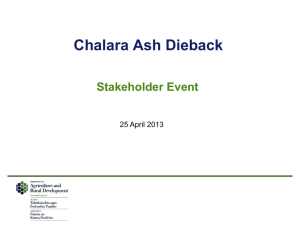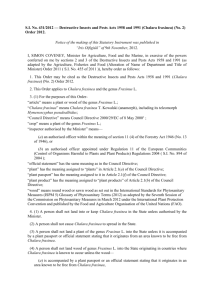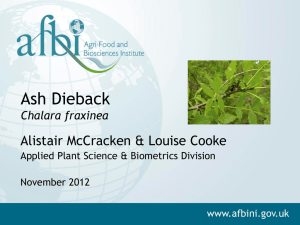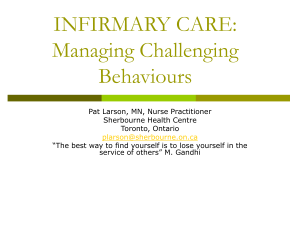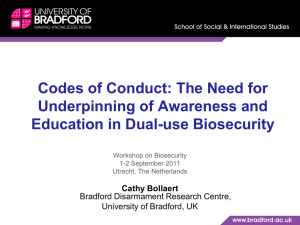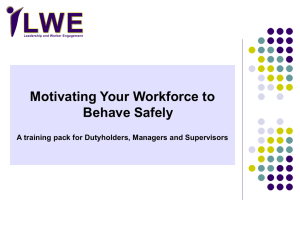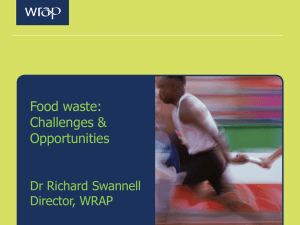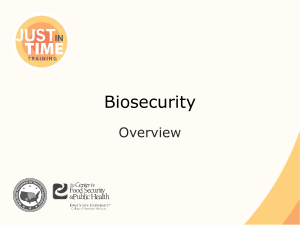Social science role in tree and plant health & biosecurity
advertisement
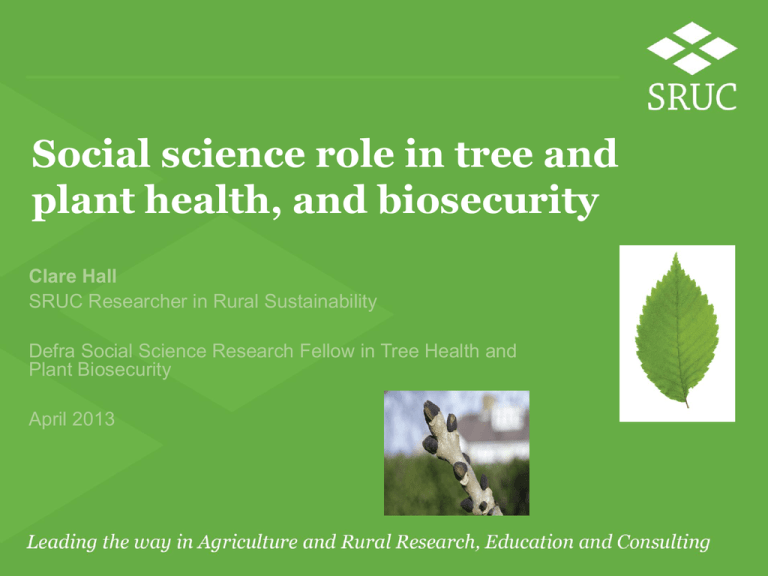
Social science role in tree and plant health, and biosecurity Clare Hall SRUC Researcher in Rural Sustainability Defra Social Science Research Fellow in Tree Health and Plant Biosecurity April 2013 Outline • • • • • • • Why the interest in social science? The role of the secondment. Work carried out during secondment. Scoping of projects. Gap analysis: Broad themes prioritised. Project ideas under each research theme. (Some results from Chalara survey) 2 Why the interest in social science? • Tree Health & Plant Biosecurity Action Plan (October 2011) – – – – Theme A: Protecting the UK – import controls Theme B: Practical actions Theme C: Public and stakeholder engagement Theme D: Research opportunities and evidence priorities – Theme D notes the need for interdisciplinary research that integrates natural sciences, social and economic evidence. – This presents challenges as forest research has a very strong tradition in the natural sciences and very little input from the social sciences. • Biosecurity is primarily about behaviours – i.e. people • Traditionally plant health policy concerned with P&Ds in horticulture / agriculture – but increasingly about P&Ds in wider environment. 3 The role of the secondment • Text from the Defra call for the fellowship • Social science research fellow supporting tree health and plant biosecurity • The role will provide social science input, advice and analysis into the area of Tree Health and Plant Biosecurity and wider Plant Health • Analysis and knowledge transfer role • The research fellow will undertake, advise on and support policyrelevant research • Will facilitate the sharing of knowledge and expertise between academia and government • The role will require interaction across a range of bodies inc: APHEA Team, Plant Health Policy Team, FC, FR. 4 Work carried out during secondment • (Formal and informal) knowledge exchange • Feeding in to various on-going processes and publications – E.g. OPAL, Chalara Management Plan England, Defra’s Tree Health and Plant Biosecurity Evidence Plan • Scoping of relevant social science research projects (and stakeholder engagement work) • Gap analysis relating to social science in the area of tree and plant health and biosecurity 5 Scoping of projects • • • • • • • • • Stakeholders: attitudes and behaviours Defra: Stakeholder mapping in relation to four pests and diseases (Emerald Ash Borer, Chestnut Blight, Great Spruce Bark Beetle, Asian Longhorn beetle). Fera HSTI: Plants of cultural significance. Bicton College: Student project – investigating public awareness of Chalara and stated willingness to engage in biosecurity behaviours. Defra: Future Proofing Plant Health: Management of Elms in Sussex and value of Elm trees. Defra: Dothistroma needle blight: social and economic analyses. EU Cost Action: PERMIT (Pathway evaluation & pest risk management in transport) • Governance projects LWEC Phase 1: Pathways Into Policy: Biosecurity governance implications of different trajectories of tree disease introductions and spread. Defra: Analysis of the management of outbreaks of Oak Processionary Moth in the UK. • • • • • • Projects relating to citizen science Fera: Pestspotter app for smart phones (Asian Longhorn Beetle). Fera HSTI: Non-native species Local Action Groups – structure and motivations. Big Lottery: OPAL (Open air laboratories) - Citizen science tree health survey. Defra: ObservaTree - Citizen science tree health early warning system. Defra: Improved methods for the early detection of Oak Processionary Moth. 6 Gap analysis: broad themes • Behaviours and the antecedents of those behaviours • Risk: Social impact, risk indicators and risk perceptions • Attitudes to new technologies for detection, surveillance, monitoring and control • Review of governance structures in plant health policy • Research issues relating to citizen science (Other ideas) 7 1) Behaviours and the antecedents of those behaviours • In the (interim) Task force report, in the Chief Scientific Adviser’s foreword, it is noted that: “the problems addressed in the report have most of their solutions embedded fundamentally in the behavioural choices made by people”. • Lots of stakeholder groups, lots of behaviours of interest, lots of possible antecedents of those behaviours. 8 Stakeholder groups are likely to encompass: • • • • • (Wood)land owners / (Wood)land managers Plant nursery managers / owners / staff Garden centre managers / owners / staff Other industry: saw-millers, landscapers, stone masons, builders merchants Plant importers • • • • • NGOs Gardeners / Consumers / Public Outdoor recreationists (inc. groups such as cyclists, walkers, birdwatchers) Tourists, inc. UK, international Media • • • • • • Plant inspectors Local authorities Transport authorities (eg BAA, Port Authorities) National government Policy makers Devolved administrations 9 Behaviours • Relevant behaviours could encompass: • • • • • • • • Adopting good biosecurity practice Information seeking Taking up training Communicating with others Complying with regulations Adopting new technologies Monitoring for pests/diseases Reporting possible sightings 10 Antecedents of behaviours • Relevant antecedents are likely to encompass: – Values (beliefs) – Attitudes (to diseases in general; to the specific pest or disease; to risk; to trees; to authorities; to the environment; to technology, and so on) – Social norms – Personal norms – Habit – Personality – Socio-demographics – Perceived behavioural control – Knowledge (self-reported and actual) – Awareness – Interest in the issue – Prioritisation of issue relative to other personal / professional / social issues – Previous experience of the issue or similar issue 11 Behaviours: Specific project ideas • Industry attitudes to management of pests and diseases – Study with industry stakeholders, e.g. nurseries, woodland managers, sawmillers, retailers and landscapers. • Comparative study of attitudes to biosecurity in New Zealand & UK – Comparative study with a range of stakeholder groups, including public, plant importers, border control staff, plant inspectors, private woodland managers etc. • (Why) are trees important to people? – “Why are oak / ash / horse chestnut / pine / other trees important to you?” – To understand why, and to what extent, public might (not) carry out biosecurity measures, take part in citizen science projects, accept disease control measures and management activities. – To understand why social impact of some P&Ds might be greater. 12 2) Risk perceptions • Perception of risk influences attitudes, decision-making, and thus behaviour • Investigate how industry stakeholders perceive the risks of pests and diseases and how this relates to biosecurity practices • Investigate how the public, gardeners, consumers (of plants etc), and outdoor recreationists perceive the risks of pests and diseases and how this relates to biosecurity behaviours 13 3) Attitudes to new technology • Disease surveillance, monitoring, detection & control are becoming more technological & reliant on new technology developments. • There is scope for investigating attitudes to new detection and surveillance technologies of those responsible for using such technologies (e.g.): • Inspectors; • citizen scientists; • (wood)land managers. • Views of public towards disease control technologies 14 4) Review of governance • Interim Task Force report recommendation: “Review, simplify and strengthen governance and legislation” • An international review of governance – Map bodies involved at different levels, from international, through EU, to UK, DAs, LAs, NGOs, land managers and owners, supply chain businesses and bodies, the public, gardeners, consumers and so on. – Describe points of power, decision making and control, action, communication, and relationships. – Identify the blockages, pressure points, gaps, failures, and so on. • Role of Defra’s Risk Management Work Stream; how recommendations are communicated; how and when stakeholders are involved in RA process. • Review governance processes in relation to specific pest or disease outbreaks (for example, Chalara, OPM, Pine tree lappet moth) as part of a ‘lessons learned’ exercise. 15 5) Research issues: Citizen science • Establish a ‘baseline’ of awareness, knowledge, capabilities, interest, motivations etc. of ‘citizen scientists’ – Citizen science projects should be designed based on an understanding (evidence base) of citizens’ • existing level of awareness, • knowledge and skills, • their interest and motivation for involvement in the issue, and • perceptions of risk of tree and plant pests and diseases. – These need investigating if aim is to ‘mobilise’ large sections of public to provide scientifically valuable data on tree & plant pests & diseases. • Data verification of citizen science project – Need to design case study citizen science project to evaluate quality of data and verify scientific value 16 Chalara survey • Bicton College • Student project • Investigating public awareness of Chalara and stated willingness to engage in biosecurity behaviours. • Online survey: Link distributed via Facebook and Twitter, and through NT, RHS, Woodland Trust, and email contacts 17 Chalara survey 192 responses 36% from Devon 18 Awareness of Chalara Have you heard of Chalara dieback of ash? 0 0.1 0.2 0.3 Yes No 0.4 0.5 0.6 0.7 0.8 0.9 0.7917 0.2083 19 Knowledge of Chalara Please indicate whether you think each of these statements are true or false. Chalara dieback of ash will attack any species of ash Young trees are particularly vulnerable and succumb to the disease rapidly. Chalara dieback of ash is not harmful to the health of people or animals. Chalara dieback of ash affects all plants and trees. There is now a ban on ash plant and seed imports into the UK. Chalara dieback of ash is spread by insects. Symptoms of Chalara dieback of ash can be visible on leaves, shoots and branches of affected trees. True False Not sure 47.40% 13.02% 39.58% 58.85% 4.69% 60.73% 15.18% 24.08% 4.17% 72.92% 22.92% 66.32% 6.32% 15.10% 40.10% 44.79% 77.60% 2.08% 36.46% 27.37% 20.31% 20 Concern about Chalara To what extent do you agree or disagree with the following statement?: 'The impact of Chalara dieback of ash is something that I am worried about.' 21 Biosecurity behaviours During or after your time spent in woodlands or wooded areas do you do any of the below? 22 Conclusions • A lot of biosecurity issues are about behaviours so we need social science to help understand these • There is scope for social science research to add value to research and policy relating to tree diseases and biosecurity • It is suggested that the following areas may be useful starting points: – – – – – Behaviours and antecedents of those behaviours Risk Attitudes to technology Governance Research issues related to citizen science 23 Thank you! Clare.hall@sruc.ac.uk 24
